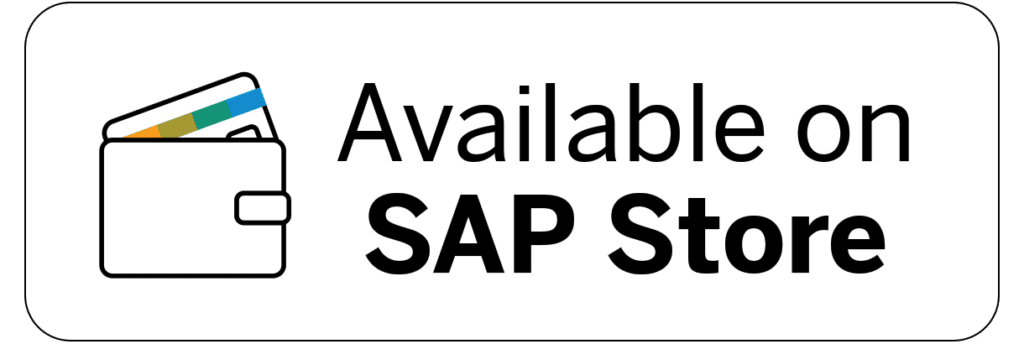Today’s workforce is in a unique position. Baby Boomers and Generation X comprise slightly over half of the workforce, while Millennials make up almost 40%. Gen Z has now reached working age, too, with an approach to work that can vary drastically from prior generations. For employers, navigating this diverse landscape can be difficult since each generation has different attitudes about work and expectations from employers — but the benefits of a multigenerational workplace are well worth the challenge.
Bridging the generational divide at work is essential for success and will only become more important as the rest of Gen Z starts working. The successful coordination of different age groups will require a multi-pronged approach, from new leadership strategies to workforce management software.
1. Understand the Multigenerational Workforce Landscape
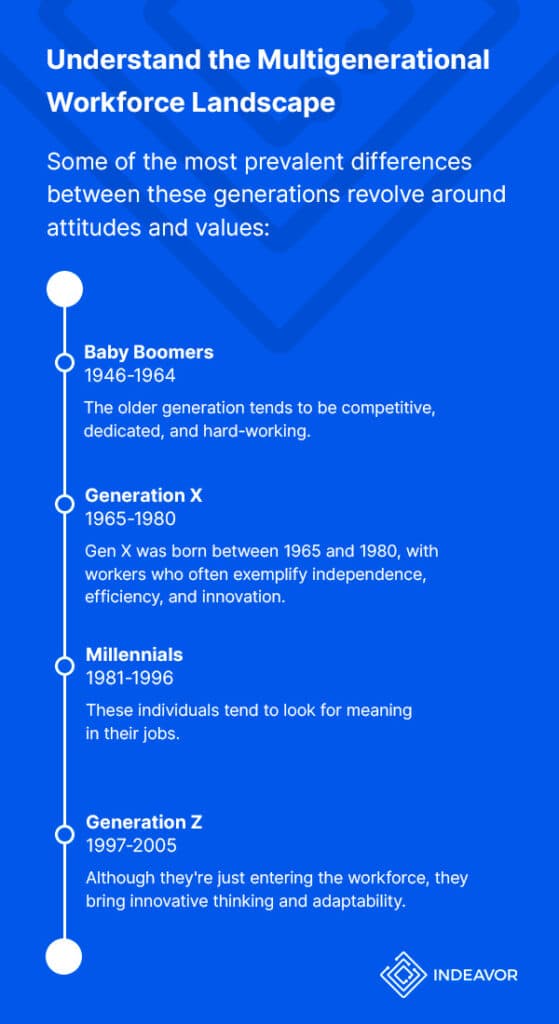
The current multigenerational workplace landscape includes an array of clashing ideologies, different styles, and opportunities. Some of the most prevalent differences leading to a generational divide revolve around attitudes and values:
- Baby Boomers: The older generation, born between 1946 and 1964, tends to be competitive, dedicated, and hard-working. They value company loyalty and hierarchies of authority. In the workplace, they often aim to inspire teams and teach younger generations. As Baby Boomers approach retirement age, they might look for flexible or reduced scheduling options.
- Generation X: Gen X was born between 1965 and 1980, with workers who often exemplify independence, efficiency, and innovation. They’re more flexible than Baby Boomers, looking for more relaxed workplaces that value productivity and autonomy over hours worked. They may take more innovative risks and challenge current procedures. Gen X usually seeks a healthy work-life balance and monetary awards, like bonuses and stock options.
- Millennials: Millennials grew up in a technological explosion. Born between 1981 and 1996, these individuals tend to look for meaning in their jobs. They want to be creative and innovative, using technology to make an impact and work more efficiently. Many Millennials want relaxed work environments and are willing to challenge the status quo or authority to get them. Since they value quality, Millennials may seek mentorship and regular feedback.
- Generation Z: Gen Z is the youngest of the bunch, born between 1997 and 2015. Although they’re just entering the workforce, they bring innovative thinking and adaptability. They often value honesty, authenticity, and connection, and they want employers to offer transparency, flexible environments, clear directions, and job security. Like Millennials, Gen Zers may prefer growth and coaching opportunities.
Unsurprisingly, these competing ideas often clash and make workforce dynamics complicated. One HR leader found that older employees tend to think Millennials and Gen Z have “fickle” work styles and unbridled honesty if things don’t go their way. Meanwhile, younger workers find the older ones uncreative, inflexible, and naïve in taking an organization’s word at face value. When workplaces put senior employees in separate environments, such as offices and meetings, they can exacerbate these issues. Young workers disengage, and older ones grow stagnant.
While the challenges are prevalent, a multi-generational workforce can also bring together people with vastly different life experiences. Savvy management can help you take advantage of these differences and find opportunities to bridge the multi-generational divide.
The Challenges and Benefits of a Multigenerational Workplace
Along with the ideological differences and stereotyping, a multigenerational workforce can also face challenges surrounding:
- Communication: Communication styles can vary dramatically between generations, often leading to miscommunications or negative feelings. Consider Gen Z’s use of emojis and casual language versus Baby Boomers’ formal and structured text. Cross-generational communication training can help workers understand and adapt to these differences without animosity.
- Technology: Closely related is the use of technology, where younger employees adapt quickly to new tools and older ones might not. These differences can cause problems with embracing new technology and collaborating effectively. Empathetic training and reverse mentorships — where younger employees support older ones — can help improve technology use while building relationships.
- Desired work styles: Determining how to reward employees can also be difficult in a multigenerational workforce. Some prefer flexible schedules and remote options, while others want structure and in-office environments. Finding the right mixture for your company will require analyzing employee sentiment and offering variety.
Despite these difficulties, a multigenerational workforce delivers many benefits. Companies can capitalize on diverse perspectives and knowledge, allowing workers to share their experiences and skills and spark creativity. Older generations can pass down their industry knowledge, while younger workers can bring new technologies and strategies to the table.
Diverse companies consistently come out on top. McKinsey’s Diversity Matters Even More report repeatedly found that diversity on executive teams leads to a higher likelihood of outperforming the competition. Since the generational divide isn’t going anywhere, focusing on diversity can revolutionize your team’s relationships for the long haul.
2. Leverage Innovative Technology
Since technology underpins most modern workplaces, leveraging it correctly can help bridge the generational divide. Digital tools that work for everyone are essential for including employees from all generations. Intuitive platforms can help meet the generations’ learning and working styles.
Digital literacy is also an excellent way to support workers of all ages — even the younger ones. For example, Gen Z might be most comfortable with texting, but they must know when to text and when to call or email in a professional setting.
Cultivating a work environment that benefits everyone supports job satisfaction and retention rates. Employers often estimate that hiring costs are three or four times higher than a position’s salary, making retention a worthwhile goal.
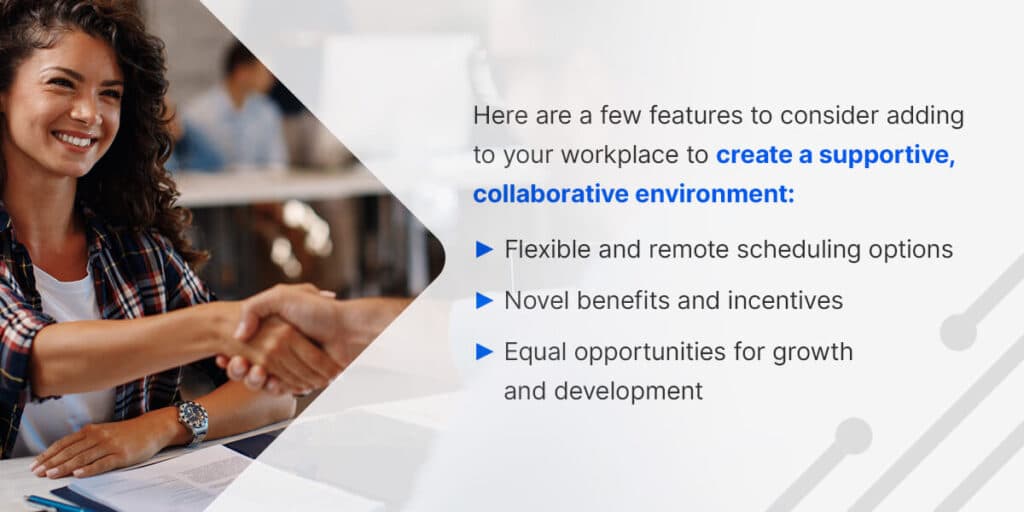
Here are a few features to consider adding to your workplace to create a supportive, collaborative environment:
- Flexible and remote scheduling options: In a 2021 study that asked employees to choose the most important benefits, flexible and remote working options took the second spot, just behind generous paid time off. While that might sound hard to offer in some fields — like hectic front-line businesses — good scheduling software can make it possible. Focus on offering tools that build flexibility, like shift swapping and requesting time off. More intelligent scheduling practices can also help you plan around time-off requests and approve them more often.
- Novel benefits and incentives: While health care, time off, and retirement plans are must-haves, some companies appeal to employees across generations with benefits like pet insurance, professional development funding, child care, financial resource planning, and fitness perks, such as a gym membership.
- Equal opportunities for growth and development: In one study from the Pew Research Center, 63% of workers cited advancement opportunities as a reason for quitting. Help your workers grow by addressing skill and competency management. Indeavor can also help you find upskilling and reskilling opportunities and ways to leverage your multigenerational employees’ skills.
3. Implement a Workforce Scheduling Solution
Your scheduling solution can play a significant role in accommodating the individual needs of a diverse workforce and managing a multigenerational workplace. Some ways your workforce scheduling can address the generational divide include:
- Meeting shift demands: Intelligent scheduling can help you match employees to the best shifts according to factors like preferences, qualifications, and skills.
- Offering self-service tools: You’ll want to offer modern tools for viewing schedules, requesting changes, and contacting supervisors. Mobile access may be particularly helpful for younger workers, and an intuitive interface is essential for some tech-averse older employees.
- Removing bias: A smart scheduler helps ensure fair and equitable scheduling — administrators can’t apply biases for certain workers, such as giving a senior employee more desirable shifts.
- Preventing burnout and violations: Employees from all generations are susceptible to burnout. Regulatory compliance and internal rules can help prevent it, which a good scheduler can accommodate, ensuring your team gets the time off they need to do their best work.
Multigenerational teams are a goldmine for collaborative potential, but you must proactively foster the right environment. You might consider employee resource groups, mentoring programs, or training about communication differences. Indeavor’s workforce insights feature can help you learn about your team’s composition to set up these initiatives.
4. Enhance Employee Engagement
Engagement can differ across generations, with some more likely to respond to certain initiatives than others. Understanding the generational divide is crucial to addressing the distinct preferences and expectations each generation has in the workplace.
Two key aspects of employee engagement across different generations include management styles and company culture. For example, younger employees may prefer more flexibility and feedback-driven leadership, while older generations might value job security and formal recognition. By tailoring engagement strategies to meet the unique needs of each generation, organizations can foster a more motivated, connected workforce.
Adapting Management Styles to Suit Diverse Needs
Managers must understand the benefits of a multigenerational workforce and their role in drawing those benefits out. Older managers can’t dismiss younger employees, and young managers must be comfortable managing older people.
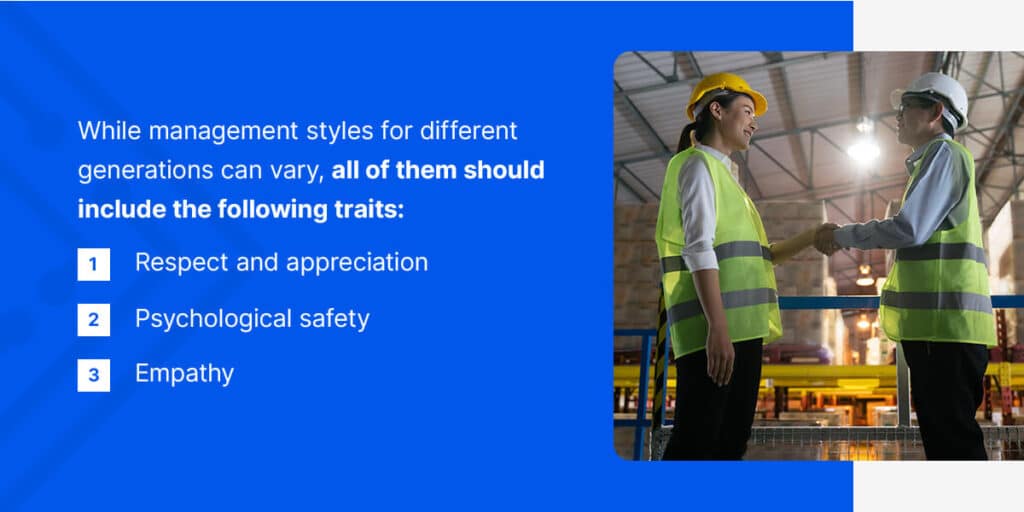
While management styles for different generations can vary, all of them should include the following traits:
- Respect and appreciation: Managers must see what each person can contribute and be open to hearing what all employees have to offer.
- Psychological safety: Psychological safety is all about feeling safe enough to take interpersonal risks, disagree openly, speak up, and raise concerns without fearing negative repercussions or needing to sugarcoat things. It’s essential in fostering innovation, collaboration, and community, and many generations value the opportunity to make a difference. McKinsey offers some leadership tips for creating psychological safety in workplaces.
- Empathy: Empathetic management should underpin all efforts to bridge generational divides at work. Animosity between these groups often occurs from negative emotions like frustration and fear. Managers must approach problems with empathy to ensure a safe, supportive environment.
Include discussions of these traits during training, and connect them with the importance of a bridging the generational divide to create a diverse, multigenerational workforce.
Building a Culture of Continuous Learning and Development
Your company’s culture will significantly impact employee engagement for different generations. Where collaboration is concerned, a culture that emphasizes the value of each person’s contributions can help people connect, despite the generational divide.
Skill-sharing sessions are a great way to have employees share their unique experiences. You can run these like presentations or pair up individual workers. For example, you might pair a veteran employee with a junior. The junior could share skills about incorporating new digital tools into the workflow, while the veteran might discuss navigating workplace relationships based on years of experience.
Another critical part of a collaborative company culture is a focus on continuous learning and development. Learning from others with different backgrounds requires an open mind, so your culture should encourage this manner of thinking from the ground up. Emphasize the importance of lifelong learning, and offer educational opportunities targeted to the individual.
5. Provide Actionable Steps for Business Managers
You’ll need to provide concrete steps to help managers bridge the workplace generation gap. Give your managers some multigenerational workplace tips for supporting employees of all ages, such as:
- Creating mentorship programs that include the knowledge of younger employees.
- Pairing employees from different generations on collaborative projects.
- Creating feedback loops, such as pulse surveys and open-door policies, to provide an avenue for making positive change.
- Set clear expectations about mutual respect and understanding, supported by a company culture of open-mindedness.
- Deploying initiatives that appeal to different generations, such as bonuses for Baby Boomers or extra time off for Millennials and Gen Z.
- Finding common goals and values among team members.
- Reskilling senior employees with learning opportunities, prolonging their careers and supporting retention efforts.
After all that hard work, you’ll need a way to measure progress. Here are some key performance indicators (KPIs) you can monitor to evaluate the success of initiatives aimed to unite the generational divide:
- Employee engagement: You can measure employee engagement in many ways, such as surveys, employee net promotor scores, interviews, absenteeism, and productivity. You may need to use multiple methods to create a holistic view of engagement.
- Turnover rate: Turnover rate is much easier to track, reflecting the percentage of employees that leave within a certain period. You could even narrow your metrics to focus on voluntary separation and early retirement.
- Employee satisfaction and feedback: Employee satisfaction is usually measured through surveys and exit interviews. You can collect more detailed information on specific aspects of the workplace, many of which are related to multigenerational challenges, like career development, leadership, diversity, inclusivity, and communication.
- Performance metrics: On a broader level, you can even look at performance metrics for individuals and the company. Diversity and collaboration tend to improve business performance. While this metric has many complicating factors, it can be helpful for the big picture.
Collecting this data is not a one-and-done task. Continuously evaluate your KPIs and look for ways to improve your approach to managing a cross-generational workplace. Employee feedback and data analysis can help you turn a multigenerational workplace strategy from good to great.
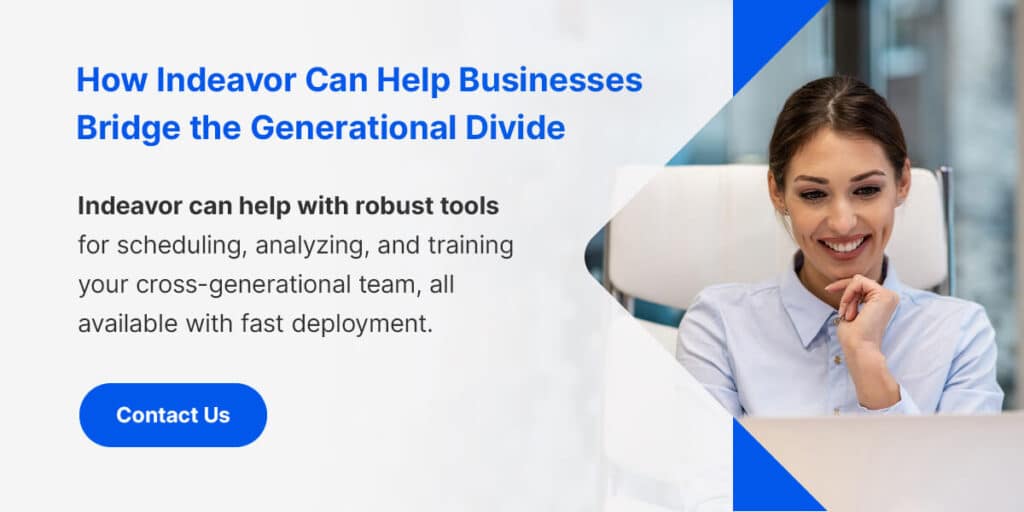
How Indeavor Can Help Businesses Bridge the Generational Divide
Managing a multigenerational workplace is no easy task, but it’s crucial and will only become more impactful as the workforce evolves. The generational divide in expectations, work styles, and communication preferences can make this even more challenging. Effective workforce management is essential for facilitating a positive environment for everyone.
Indeavor can help with robust tools for scheduling, analyzing, and training your cross-generational team, all available with fast deployment. For example, our skill management software allows you to create a skills management framework and monitor progress with competency levels and skill statuses.
HR professionals, managers, and business owners use Indeavor’s versatile and intuitive capabilities to improve workforce management and create a cohesive, collaborative workplace for all generations. Contact our team today to learn more about how Indeavor can help your business navigate the generational divide and build a stronger workforce.







